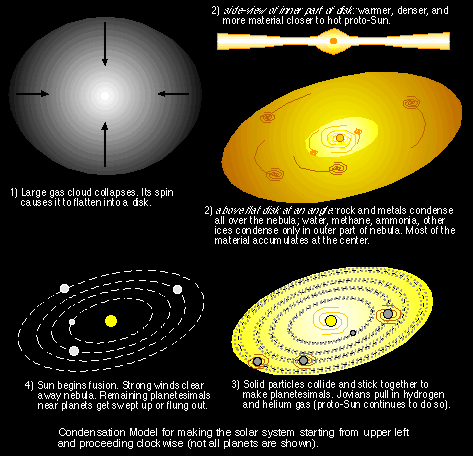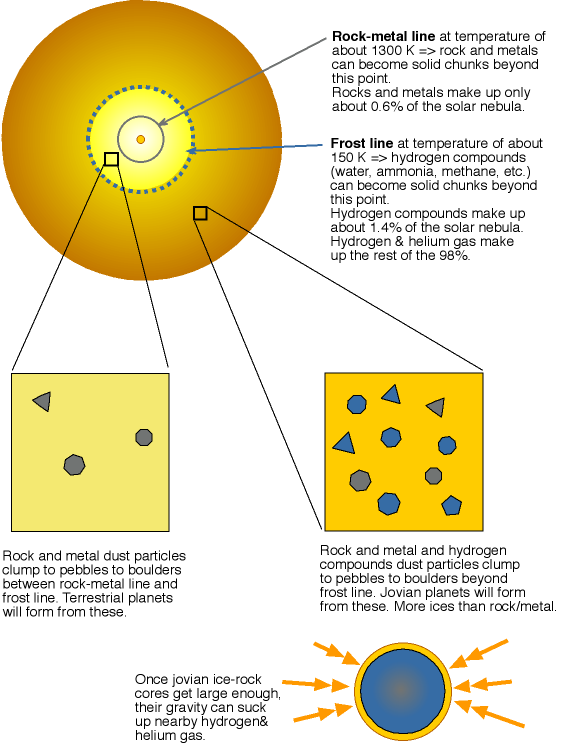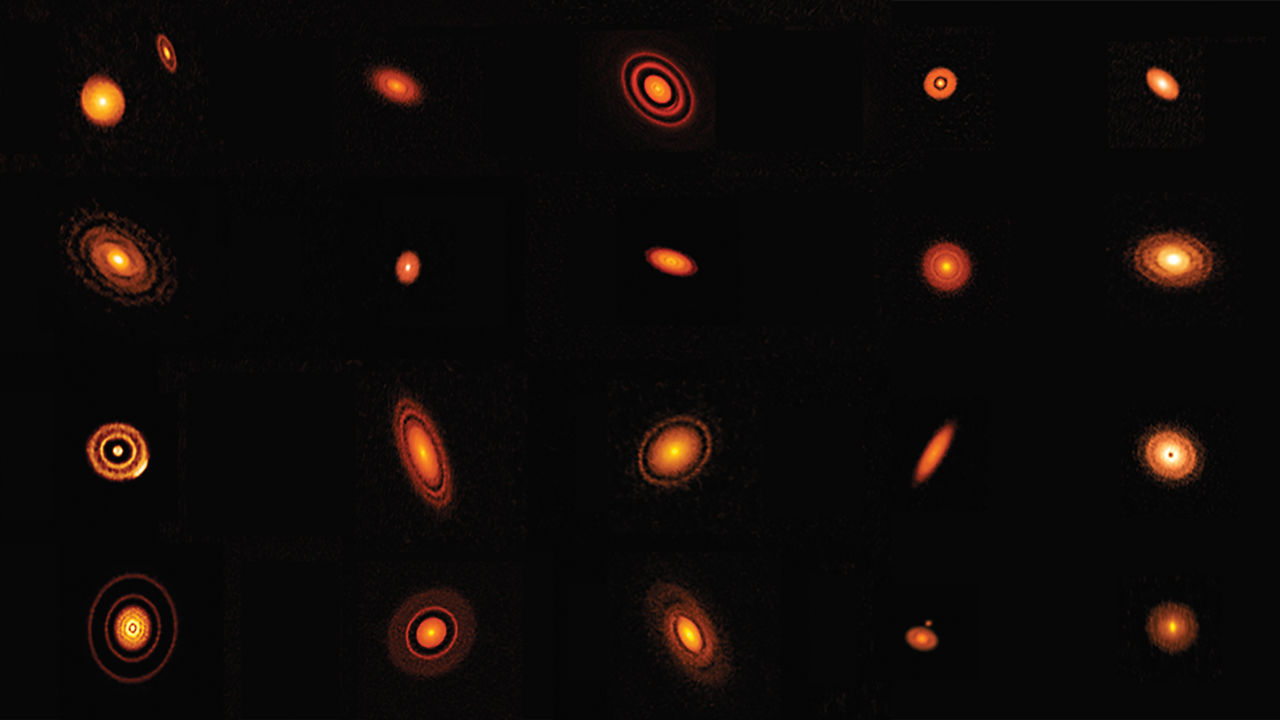Video lecture for this page
This material (including images) is copyrighted!.
See my copyright notice for fair use
practices.
The radioactive dating of meteorites says that the Sun, planets, moons, and
solar system fluff formed about 4.6 billion years ago. What was it like then? How did
the solar system form? There are some observed characteristics that any model of the
solar system formation must explain.
- a.
- All the planets' orbits lie roughly in the same plane.
- b.
- The Sun's rotational equator lies nearly in this plane.
- c.
- Planetary orbits are slightly elliptical, very nearly circular.
- d.
- The planets revolve in a west-to-east direction. The Sun rotates in the
same west-to-east direction.
- e.
- The planets differ in composition. Their composition varies roughly with
distance from the Sun: dense, metal-rich planets are in the inner part and giant,
hydrogen-rich planets are in the outer part.
- f.
- Meteorites differ in chemical and geologic properties from the planets
and the Moon.
Comets sampled by spacecraft are made of a mixture of rock/metals and hydrogen-rich compounds.
- g.
- The Sun and most of the planets rotate in the same
west-to-east direction. Their obliquity (the tilt of their rotation axes with respect
to their orbits) are small. Uranus and Venus are exceptions.
- h.
- The rotation rates of the planets and asteroids are similar---5 to 15 hours,
unless tides slow them down.
- i.
- The planet distances from the Sun obey Bode's law---a descriptive law
that has no theoretical justification. However, Neptune is a significant exception
to Bode's "law" .
- j.
- Planet-satellite systems resemble the solar system.
- k.
- The Oort Cloud and Kuiper Belt of comets.
- l.
- The planets contain about 90% of the solar system's
angular momentum but the Sun contains over 99% of
the solar system's mass.
The model that best explains the observed characteristics of the present-day
solar system is called the Condensation Model. The solar system formed from
a large gas nebula that had some dust grains in it. The nebula collapsed under its
own gravity to form the Sun and planets. What triggered the initial collapse is not
known. Two of the best candidates are a shock wave from a nearby supernova or from
the passage through a spiral arm. The gas cloud that made our solar system was
probably part of a large star formation cloud complex. The stars that formed in
the vicinity of the Sun have long since scattered to other parts of the galactic
disk. Other stars and planets in our galaxy form in the same basic way as will be
described here. The figure below summarizes the basic features of the
Condensation Model. After the figure is further explanation of the model
and how it explains the observable items in the previous section.

- A.
- A piece of a large cloud complex started to collapse about five billion years
ago. The cloud complex had already been "polluted" with dust grains from previous
generations of stars, so it was possible to form the rocky terrestrial planets.
As the piece, called the solar nebula collapsed, its slight rotation
increased. This is because of the
conservation of angular momentum.
- B.
- Centrifugal effects caused the outer parts of the nebula to flatten into a
disk, while the core of the solar nebula formed the Sun. The planets formed from
material in the disk and the Sun was at the center of the disk. This explains
items (a) and (b) of the observables above.
Disks are seen around most of the young lower-mass stars in our Galaxy today, so we know that this part of the model is a common process in star formation.
- C.
- Most of the gas molecules and dust grains moved in circular orbits. Those on
noncircular orbits collided with other particles, so eventually the noncircular
motions were dampened out. The large scale motion in the disk material was parallel,
circular orbits. This explains items (c) and (d) of the observables above.
- D.
- As the solar nebula collapsed, the gas and dust heated up through
collisions
among the particles. The solar nebula heated up to around 3000 K so everything was in
a gaseous form. The solar nebula's composition was similar to the present-day Sun's
composition: about 93% hydrogen, 6% helium, and about 1%
silicates and iron, and the density of the gas and dust increased toward the core where the proto-Sun was.
The inner, denser regions collapsed more quickly than the outer regions.
When the solar nebula stopped collapsing it began cooling, though the core forming
the Sun remained hot. This meant that the outer parts of the solar nebula cooled off
more than the inner parts closer to the hot proto-Sun. Only metal and rock materials
could condense (solidify) at the high temperatures close to the proto-Sun.
Therefore, the metal and rock materials could condense in all the
places where the planets were forming. Volatile
materials (like water, methane and ammonia) could only condense in the outer parts
of the solar nebula. This explains item (e) of the observables above.
Around Jupiter's distance from the proto-Sun the temperature was cool enough to
freeze water (the so-called "snow line" or "frost line" ). Further out from the proto-Sun, ammonia
and methane were able to condense. There was a significant amount of water
in the solar nebula. Because the density of the solar nebula material increased
inward, there was more water at Jupiter's distance than at the distances of Saturn,
Uranus, or Neptune. The greater amount of water ice at Jupiter's distance
from the proto-Sun helped it grow larger than the other planets.
Although, there was more water closer to the Sun than Jupiter, that
water was too warm to condense.
Material with the highest freezing temperatures condensed to form the
chondrules that were then incorporated in lower freezing temperature material.
Any material that later became part of a planet underwent further heating and
processing when the planet differentiated so the heavy metals sunk to the planet's
core and lighter metals floated up to nearer the surface. The first part of observables item (f) is
explained.

The inner planets were not totally devoid of volatile material, though. Water could still be incorporated into the
minerals to form hydrated minerals that could survive the extreme heat of the inner part of the solar system without all being vaporized away, even during the phase of numerous, large impacts in the early solar system. The three comets sampled up close by spacecraft, Tempel 1, Wild 2 and Churyumov-Gerasimenko, are made of a mixture of materials with
high and low melting temperatures (second part of observables item (f)). Therefore, the materials making them up would have come from different parts of the early solar system and there was more mixing in the solar nebula than previously thought. The still-forming proto-Sun probably produced strong winds as seen in young, protostars today and those winds could be responsible for at least part of the mixing of solar nebula materials.
- E.
- Small eddies formed in the disk material, but since the gas and dust particles
moved in almost parallel, near-circular orbits, they collided at low velocities.
Instead of bouncing off each other or smashing each other, they were able to stick
together through electrostatic forces to form planetesimals. The larger
planetesimals were able to attract other planetesimals through gravity and increase
in size. This process is called accretion.
The coalescing particles tended to
form bodies rotating in the same direction as the disk revolved. The forming planet
eddies had similar rotation rates. This explains items (g) and (h) above. The gravity
of the planetesimals tended to divide the solar nebula into ring-shaped zones. This
process explains item (i) above.
- F.
- More massive planetesimals had stronger gravity and could pull in more of the
surrounding solar nebula material. Some planetesimals formed mini-solar nebulae
around them which would later form the moons. This explains item (j) above.
The Jupiter and Saturn planetesimals had a lot of water ice mass, so they swept up a
lot of hydrogen and helium. The Uranus and Neptune planetesimals were smaller so
they swept up less hydrogen and helium (there was also less to sweep up so far out).
The inner planetesimals were too small to attract the abundant hydrogen and helium.
- G.
- The small icy planetesimals near the forming Jupiter and perhaps Saturn were flung out
of the solar system. Those near Uranus and Neptune were flung to very large orbits.
This explains the Oort Cloud of item (k) above, though some of the gravitational flinging by Uranus and Neptune would have been weaker to form the closer scattered disk. There was not enough material to
form a large planet beyond Neptune. Also, accretion of material at these great
distances progressed more slowly than material closer to the Sun. The icy
planetesimals beyond Neptune formed the Kuiper Belt.
The large planets were able to stir
things up enough to send some of the icy material near them careening toward the
terrestrial planets. The icy bodies gave water to the terrestrial planets.
Recent sophisticated computer simulations have shown that gravity interactions between the giant planets themselves could have changed their orbits from the ones they originally had. Jupiter would have slowly spiraled inward while Saturn, Neptune, and Uranus would have slowly spiraled outward until Saturn reached the point where it took twice as long to orbit the Sun as Jupiter. This 1-2 resonance would have greatly changed the orbits of Neptune and Uranus, even to the point of shifting Neptune's closer orbit to a much larger one outside of Uranus' orbit. Older versions of the Condensation Model had difficulty explaining the formation of a planet the size of Neptune at Neptune's current distance from the Sun because of the amount of available material in the solar disk would have been too small at that distance from the forming Sun. If Neptune had formed much closer in than it is now and later moved to its present position, then the problem goes away. In addition, the onset of the 1-2 Jupiter-Saturn resonance would have led to a sudden scattering of planetesimals which would explain the possible spike in the number of giant impacts throughout the solar system about 3.8 billion years ago (as well as halting Jupiter's inward spiral).
- H.
- The planets got big enough to retain heat and have liquid interiors. The heavier
materials like iron and nickel sank to the planet cores while the lighter materials
like silicates and gases rose toward the surface, in a process called
differentiation. The sinking of the heavy material created more heat energy.
The planets also had sufficient radioactive decays occurring in them to melt rocky
material and keep it liquid in the interior. The small planetesimals that were not
incorporated into the large planets did not undergo differentiation. This explains
the first part of item (f) of the observables.
- I.
- The proto-Sun had a magnetic field and spewed out ions. The ions were dragged
along by the magnetic field that rotated with the proto-Sun. The dragging of the
ions around slowed down the proto-Sun's rotation rate. Also, accretion
disks like the solar nebula tend to transfer angular momentum outward as they
transfer mass inward. This explains item (l) above.
- J.
- Because of its great compression, the core of the proto-Sun core reached about
10 million Kelvin and the hydrogen nuclei started fusing together to produce helium
nuclei and a lot of energy. The Sun "turned on." The Sun produced strong winds
called T-Tauri winds that swept out the rest of the nebula that was not
already incorporated into the planets. This whole process took just a few hundred
million years and was finished by about 4.6 billion years ago.
After forming the disk, the disk would have cooled as the heat was radiated to space. However, before ices could condense and clump closer to the proto-Sun than the "frost line" , the Sun went through the T-Tauri stage and the strong winds swept out the remaining gas including the hydrogen compounds. If the nebula had cooled more quickly, the inner planets might have been able to get bigger and have more hydrogen compounds in them. If the nebula was warmer, then the "frost line" would have been further out, so Jupiter would have been a terrestrial planet. The ice cores forming beyond about Neptune's current distance never got big enough to capture the surrounding hydrogen and helium gas---they stayed small to become the dwarf planets such as Pluto, Eris, Makemake, Haumea, etc. and the other Kuiper Belt Objects.
Although the Condensation Model explains a number of observed facts of the properties of the present-day solar system, we have
been looking at a sample size of just one: our solar system. It has been only relatively recently that we have been able to test
the theory with other forming and fully-developed planetary systems with the placement of powerful telescopes above the Earth's atmosphere and the development of very sensitive instruments for ground-based telescopes and analysis techniques. Observations in the infrared and sub-millimeter wavelengths have enabled us to peer through the thick dust that shields forming stars and their planetary disks. In some cases some of the dust/gas cocoons have been stripped away by ultraviolet light from nearby very hot stars so we can study them in optical wavelengths. These star formation processes will be explored a bit more fully in another chapter, but I will note briefly here that the processes described above are seen in other forming planetary systems and a great majority of forming stars have flattened disks with them so planet formation (or at least the "solar nebula" disk formation part) is a common process.

Protoplanetary disks imaged by the Atacama Large Millimeter/submillimeter Array (ALMA) in Chile show gaps made by planets clearing out particles in their orbits. The gaps appear more quickly than expected (some after just a million years instead of the expected many millions of years).
We have used those observations to modify and improve the Condensation Model. In particular our observations of other planetary systems has forced us to seriously explore how
planets can migrate inward from where they first started forming. Perhaps, one should not be surprised that that could happen. As described in item G above, gravitational interactions flung chunks of material all about. As described in the next section, the observations show that gravitational interactions can shift things as big as planets as well as small planetesimals.
- What observed facts does the Condensation Model of the solar system
formation explain?
- From what did the solar system form?
- Why are the inner terrestrial planets small and rocky while the outer jovian
planets are large and gaseous?
- Why does a disk form in the collapsing cloud?
- What role do dust particles play in planet formation?
- If the disk was moving so quickly, how did it create big enough clumps to make
planets?
- What drove out the rest of the nebula after the planets formed?
- Why are the planet interiors made of layers of increasing density closer to their
cores?
- How do we test the Condensation Model of the solar system?
 Go back to previous section --
Go back to previous section --
 Go to next section
Go to next section
last updated:
June 17, 2022
Is this page a copy of Strobel's
Astronomy Notes?
Author of original content:
Nick Strobel



![]() Go back to previous section --
Go back to previous section --
![]() Go to next section
Go to next section